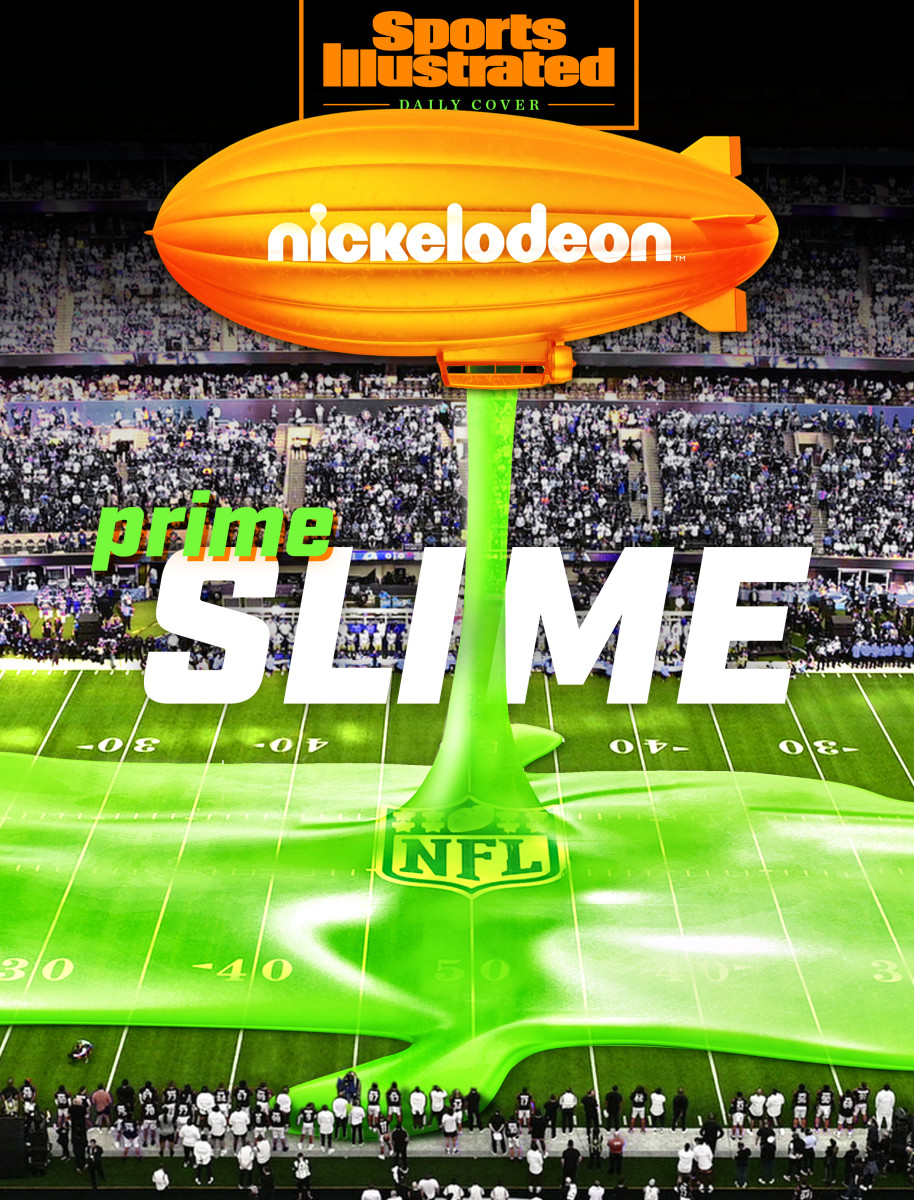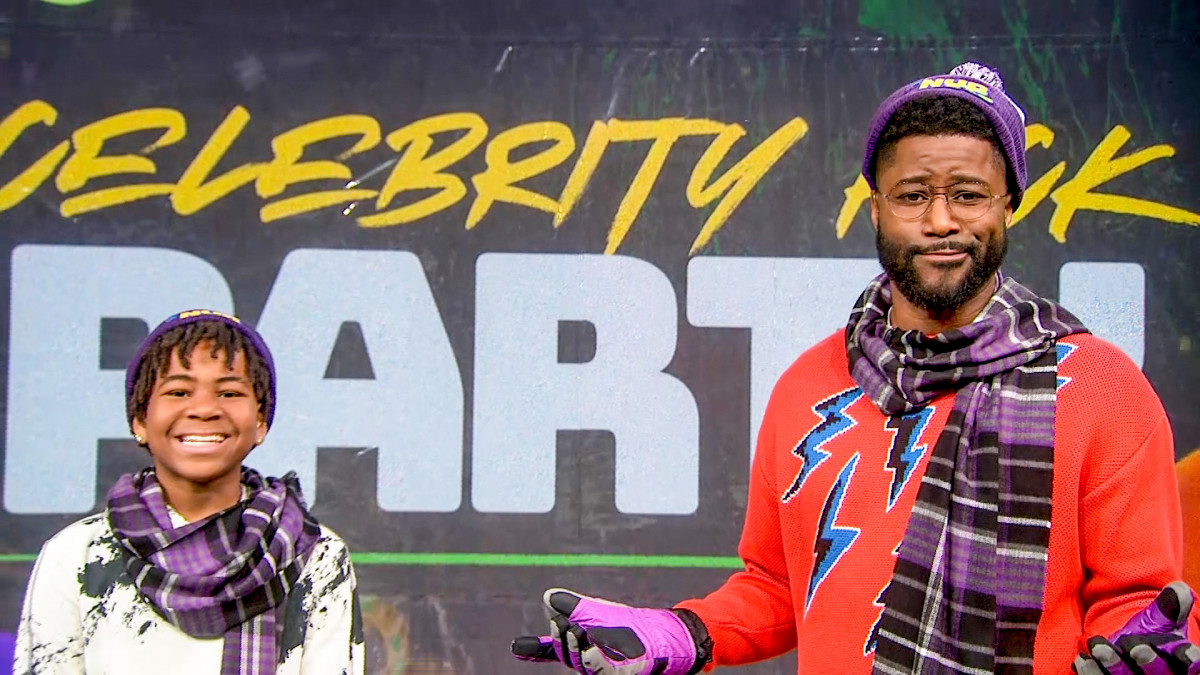SpongeBob, Slime and ... Russell Wilson? Nickelodeon’s Circle Grows Into Football and Golf.
On a Tuesday afternoon in November, former NFL wide receiver Nate Burleson stood patiently in a CBS studio as slime was applied to his face. A Nickelodeon crew member armed with a ketchup bottle full of the green stuff squirted tiny globs onto a rag and carefully dabbed him with it.
His NFL Slimetime cohost, 13 year-old Young Dylan (né Dylan Gilmer), who also stars in the channel’s Tyler Perry vehicle (also named Young Dylan), met the same fate.
“Here we go, champ,” Burleson chanted to his lightly complaining coworker by way of motivation. “Here we go.”

Burleson and Dylan were about to go blobbing for apples. Yes, blobbing: bobbing, but Nickelodeon-style, in a vat of slime. Each fruit that Burleson and his NFL Slimetime cohost extracted bore the logo of a football team—together representing the pair’s three picks for the following week of games.
The stage manager bellowed: “Let’s be ready to shoot this, because [the slime] is at its drippiest right now.” And so they plunged their faces into the vat, shooting one of the Week 11 episode’s last segments, which displayed the Jets, Broncos and Vikings picks. A day of taping football headlines, highlights (or “slimelights”) and some light analysis was nearly complete. Confetti and dancing followed.
NFL Slimetime is not to be confused with the out-of-control-messy Slime Time Live of the early aughts, in which random, eager children visiting the network’s since-shuttered Orlando studio got pied and slimed into oblivion outdoors as a “reward” for completing games and answering trivia questions. No, the modern weekly half-hour show is in its second season, and the use of slime is decidedly more restrained and sophisticated. Young Dylan isn’t the only kid involved in this production—the next generation of NFL “insiders” also includes, apparently, Burleson’s daughter, Mia, and another Dylan, the daughter of ESPN reporter Adam Schefter. They interview prominent players and break down key facts about them, adding color to the show.
NFL teams and athletes actively participate in NFL Slimetime, too: Each Wednesday evening on the show, Nick hands out an “NVP” award to that slate’s best performer. On that day a package with a trademark bright-orange blimp (the channel’s longtime logo) was headed to Indianapolis for Colts running back Jonathan Taylor, along with two gallons of slime for his teammates to accost him with. Shawn Robbins, who executive-produces the show, proudly says, “[The NVP is] the only way [athletes] can get a blimp,” since the cancellation of the Kids’ Choice Sports award show in 2019. And they really do seem to covet those blimps, which have long been an unlikely status symbol among not just kids but also the Hollywood and sports elite.

When riffing on Nickelodeon’s deep dive of the past few years into professional sports, one verb is unfortunately inescapable: Nickify. The word itself is an important branding exercise, and it also signifies the emphasis put on IP like SpongeBob and its associated visuals. Ashley Kaplan, whose job, in part, is to oversee unscripted TV at Nickelodeon, says there is almost no reason not to use famous IP (Nick seems to air a whole lot of Paw Patrol and SpongeBob these days) to put a twist on straight sports content. It’s a “yes, and” situation, she says. Sports Illustrated’s Conor Orr wrote about his first encounter with this form of sports broadcast, the 2021 Nick wild-card game that he expected to dislike, thusly:
To be honest, my [column] plan was an unoriginal Fear and Loathing rip-off where we talked in great detail about the neon green and orange psychedelia adorning the field and how the random insertion of SpongeBob SquarePants characters felt like an intrusive pandemic lockdown fever dream; the moment when all of the haunting childhood cartoons and songs that live in our heads throughout the endless, eventless days finally seep their way into the adult programming we use to escape that reality for a few moments every weekend. A real hellscape, of sorts.
But, he eventually concluded, the broadcast was “a revelation” for him—and maybe for others, too. Slime-drenched shenanigans, as it turns out, can be part of a worthwhile exercise in taking sports a touch less seriously.
Beyond football, Nick has dived into a considerably harder task of getting kids to watch golf. The channel’s taped Slime Cup in June featured once-world No. 1 golfer Jon Rahm and NFL players Saquon Barkley and Justin Herbert, among other golfers and celebrities. But the level of Nickification that would suffice to entice kids during a football broadcast just wouldn’t do for golf. There had to be more gimmicks. A lot more.
The seven-hole experience—and it is quite an experience—pitted four teams against one another: each with a golfer, a child personality, and a non-golf athlete. Vaguely golf-adjacent challenges that preceded the actual swings included the kids racing to down a rancid combination of hot fudge, anchovies, sprinkles, clam sauce, marshmallows and asparagus. The losing kid’s whole team had to wear Teenage Mutant Ninja Turtles costumes of shame while they played the subsequent hole. The golf pros had only wacky, inconvenient clubs at their disposal. Get the idea? For the title, Rahm’s and Justin Thomas’s squads ultimately faced off in the Rose Bowl, whose field was pocked with slime cannons.
Nickelodeon has greatly bolstered its football coverage in recent years, which had previously been limited to two wild-card weekend game simulcasts with CBS (a Paramount sister network), in 2021 and ’22. Next up for Nick: the Christmas Day game simulcast between the Broncos and Rams—a matchup that must’ve sounded more compelling to the league and networks before the season got underway. Nevertheless, they’re promising to make the best of it. The Nickelodeon NFL Nickmas Game, as it’s called, will be anchored by commentary from Burleson and Noah Eagle (son of the legendary Ian), sideline reporting from Young Dylan and live commentary from [checks notes] Patrick Star. One can imagine the end-zone slime cannons and character overlays of years past will persist.
This extended foray into professional sports is not from exactly the same playbook as the iconic, pseudo-athletic-related Nick programming of decades past—Double Dare, GUTS and Wild & Crazy Kids chief among them. But events like the simulcasts, NFL Slimetime and the Slime Cup harness the elements that made those shows what they were to give us a pro sports viewing experience that’s unique, unmistakably gooey and frequently fun.

Julie Dobrow, a professor of child study, human development and media at Tufts, observes, correctly, “You can’t have Nickelodeon programming without slime.” Burleson adds, “When you have the opportunity to play with slime, you get lost in it.”
Rahm claims he wouldn’t have even competed in the Slime Cup if he wasn’t going to get doused in the radioactive-looking stuff. “That’s the whole fun of it, right?” he asks. “If I’m not getting slimed from head to toe, why even do it?” (He did, in fact, get slimed, with some fraction of the 660 gallons on hand for the Cup.)
Mathew Klickstein, the author of Slimed!, an excellent oral history of the early days of Nickelodeon, posits that we love slime because it ties into humor researcher Peter McGraw’s idea of “benign violation,” other examples of which include play-fighting and tickling—stimuli that might present a threat but are, at their core, safe and even exciting when done right. As Klickstein explains it, “[Slime] is so irreverent. It is exactly what you’re not supposed to do. It’s mess. It’s slop. It’s filth. It’s almost garbage. It’s almost like toxic waste. It even kind of looks like it. It’s bright green. Yet you’re playing with it. You’re engaging with it.”
Even Young Dylan—who earlier didn’t seem so appreciative of its engagement with his face—sings slime’s praises. “My favorite part of filming the show might be the dirtiest stuff ever, going in the slime,” he says. “Everybody I talk to that watches the show loves when we go in the slime. It’s slime—everybody loves slime.”
Slime is goopy and gloppy and gross, but in theory it shouldn’t permanently ruin your clothes, your hair or the floor. It’s all temporary. And it’s key to Nickelodeon’s past and present, starting in the 1980s with You Can’t Do That on Television, which was comedy sketches, not sports. But Double Dare was sports, in its own disgusting way. It was catching pies in your oversized pants and shoving your hands up giant mucus-y nostrils to snag a tiny flag. (For kids of a certain age, because they’re universally gross and obsessed with gross things the more their parents want them to be prim and proper, absolutely nothing was more captivating than the sight and feel of those nostrils.) It was allowing Marc Summers (who made a recent NFL Slimetime cameo) to bring out the doofus in you and in himself. It was the best.
The slime-free stuff, like GUTS, was also sports. It pitted kids against each other in various goofy, bungee-corded competitions to vie for a piece of the booby-trapped Aggro Crag they had to climb to claim victory, all while Mike O’Malley shouted his lovingly deranged play-by-play. It was also the best.
Shows like these eventually ran and reran on a separate Viacom channel, since revived and once more shuttered, called Nickelodeon Games and Sports for Kids. “What I thought was great about Nickelodeon back in those days is that it wasn’t about branding and selling consumer products. It was about entertaining kids,” O’Malley says. “The whole conceit of GUTS was a kid sees his favorite athlete dunk a basketball. He wants to know what that feels like. How do we simulate that for him and then put that in a competition?”
It’s a departure, then, or at the very least a pretty drastic evolution, to delve into real sports and replace the eager kiddos on broadcasts with [extremely Rugrats voice] grown-ups. Grown-ups who know what they’re doing and have made careers out of tackling and throwing and catching and even putting. The kid becomes the spectator, rather than a would-be participant waiting to shoot their shot.
Has Nick, then, with its interest in professional sports, fully severed ties from its charming game show history? “Uh, I’m not gonna go there,” says GUTS cocreator Albie Hecht with a laugh.
Robbins sees his work as a departure from the past, as well. “It’s completely different to do what’s been done before [on Nickelodeon] as far as sports and be on the fringe, whereas now we’re in it,” he says. “We’re in the game.”
Burleson prefers to think about Nick’s forays into football and golf as a “dive, cannonball-style, into the deep end of slime when it comes to sports.” He sees GUTS and its ilk as direct predecessors, a dip in the shallow end of the pool, to more sports-centric programming like NFL Slimetime. But whether it’s a new step or a “yes, and” built atop the old, it’s clear that Nickelodeon has struck (gunky) gold.

In sharing its IP with Nickelodeon, the NFL can shore up its younger audience before those kids are even eligible for Pop Warner football. Sure, kids can watch Fox or CBS with their parents, but the broadcast doesn’t feel like it’s for them in the same way. The terms are complicated, the players may be unfamiliar and there are no kids on the field or in the broadcast booth to describe what’s happening.
“I understand why the NFL is making the broadcast—because they’re trying to create more fans,” O’Malley says. “From the NFL’s perspective, why wouldn’t you?”
The benefits of the partnership for Nick are obvious, too. The 2021 and ’22 wild-card game simulcasts on the network drew 2.061 million and 1.333 million viewers, respectively. The ’21 edition, in which the Saints defeated the Bears, was the most-watched program on Nickelodeon in four years, and the 30.653 million total viewers (Nick and CBS combined) were the most of any NFL wild-card weekend game that season. For the Slime Cup, 315,000 viewers tuned in.
There’s also a clear qualitative benefit. “Nickelodeon is adding its icons for branding purposes,” Dobrow says, quipping, “but they’re also adding SpongeBob because kids like SpongeBob.”
Perhaps as important as the sheer numbers and the opportunity to burn SpongeBob’s laugh into everyone’s brain are the co-viewing experiences the simulcasts, NFL Slimetime and the Slime Cup can generate among family members. “If a parent from our generation is sharing with their 10-year-old something from a Nickelodeon sports broadcast, they’re not just sharing that sports broadcast, they’re sharing Nickelodeon,” Klickstein says.
That’s a big feat, with YouTube, Instagram, TikTok, video games, other linear channels (Cartoon Network, the Disney Channel) and more options increasingly competing for kids’ media consumption time. “Nowadays, kids are so distracted by everything,” Robbins says. “This is really just another way to get kids into something, which is football, something they can share.”

It’s clear that Nickelodeon is getting kids interested in football and golf from a young age. The golf part, at least, makes immediate sense—it’s a sport that doesn’t traditionally appeal to young people, and the Slime Cup show had to take the time to define terms like chip shot and mulligan. “I think it has the ability to bring the sport to a totally new set of eyeballs that don’t watch it,” says Excel Sports Management vice president Kevin Hopkins, an executive producer on the Slime Cup and The Match. (He, too, peppers his thoughts with “Nickify.”) When discussing ways to grow the sport, Hopkins puts the Slime Cup in the same category as Topgolf, the bowling-esque leisure activity that replaces lanes with a driving range.
But on the football side, in a league particularly rife with head injuries, violent tackles and suspensions related to sexual misconduct, Nickifying might not be a good thing. “There has always been a lot of concern about the question of violence in media and its possible effects on children,” Dobrow says, noting that there have been thousands of studies done on the topic in the U.S. and worldwide. “My own reading of it is that there’s [a connection] there.” She also says she bets researchers will pounce on the chance to study the impact of a sport like football being shown as part of programming for kids.
There is precedent for Nick handling sensitive subjects with care. The long-running program Nick News, originally hosted by journalist Linda Ellerbee, routinely explained subjects like Sept. 11, global warming and sexual harassment to viewers in a kid-friendly but serious and informative way. There’s no reason the NFL and Nick couldn’t take that approach to controversial on- and off-field issues that arise in NFL coverage.
Take Deshaun Watson’s suspension in light of 29 massage therapists sharing their accounts of sexual harassment and assault, or Tua Tagovailoa’s consecutive head injuries and the way they were arguably mishandled by the Dolphins and the league. But Nick would have to actively decide to go the route of incorporating those elements into its simulcasts and NFL Slimetime, rather than ignoring those issues and hoping that those seeking more information think to flip to CBS, the broadcast of record. Nickelodeon referred SI to the NFL when asked for comment about the partnership between the network and the league as it relates to injuries and misconduct. The league declined to make a representative available for an interview and issued the following statement: “We have been working with our broadcast partners for several years now to think of new and different ways around game presentation. The Nick broadcasts were a result of our conversations and the creativity of the folks at CBS Sports and have been very well received.”
Dobrow sees the utility in the prospect of Nick potentially being open about the hazards that come with promoting the NFL. “What a public service that would be for [Nickelodeon] to be talking about some of the issues of head injuries,” she says. “I’m speaking as a mother to four kids, two of whom between the two of them have five concussions.” O’Malley has a take, too. “Are you kidding me? I have three kids. Kids … have to have active shooting drills,” he says, meaning surely they can also handle controversies in other areas of life. “Everybody’s gotta stop clutching their pearls, man.”
Burleson, when he’s not blobbing for apples, believes he can explain anything in a context kids will pick up on. “A player getting suspended for something is like getting suspended from your school,” he says. “You did something bad. You have to face the consequences. … [The wild-card simulcasts weren’t] Football for Dummies. It was more football for fans that aren’t as hardcore.”
There’s some obvious room for growth in the not-quite–for Dummies approach Nick has taken to sports. Hopkins is “in conversations” with Nick brass about turning the Slime Cup into a franchise. The NFL beat is clearly going strong, for good and ill. What else could be Nickified? The answer is probably closely tied to what sports and leagues the Paramount family has rights to (NWSL, anyone?), but:
Major League Baseball, if you ask O’Malley, both with slime cannons every time Aaron Judge mashes a homer, and with Little League tournaments on Nick so kids can see their peers play. Hockey and basketball, if you ask Hopkins. Basketball, in fact, was a popular choice among those polled. Young Dylan thinks that would be “fire.” (Imagine the NBA All-Star weekend dunk contest!) Burleson would like to “Nickify up” the Olympics. Rahm’s gut answer is pickleball, which he thinks kids must be getting into anyway, as the sport’s popularity soars among people of all ages.
Meanwhile, back in the pseudo-sports realm, Hecht is holding out hope for a GUTS reboot he’s developing: He wants to combine bungee jumping and cornhole and have adult contestants. It’s an event that kids of all ages will love in its original form. No Nickification needed.
